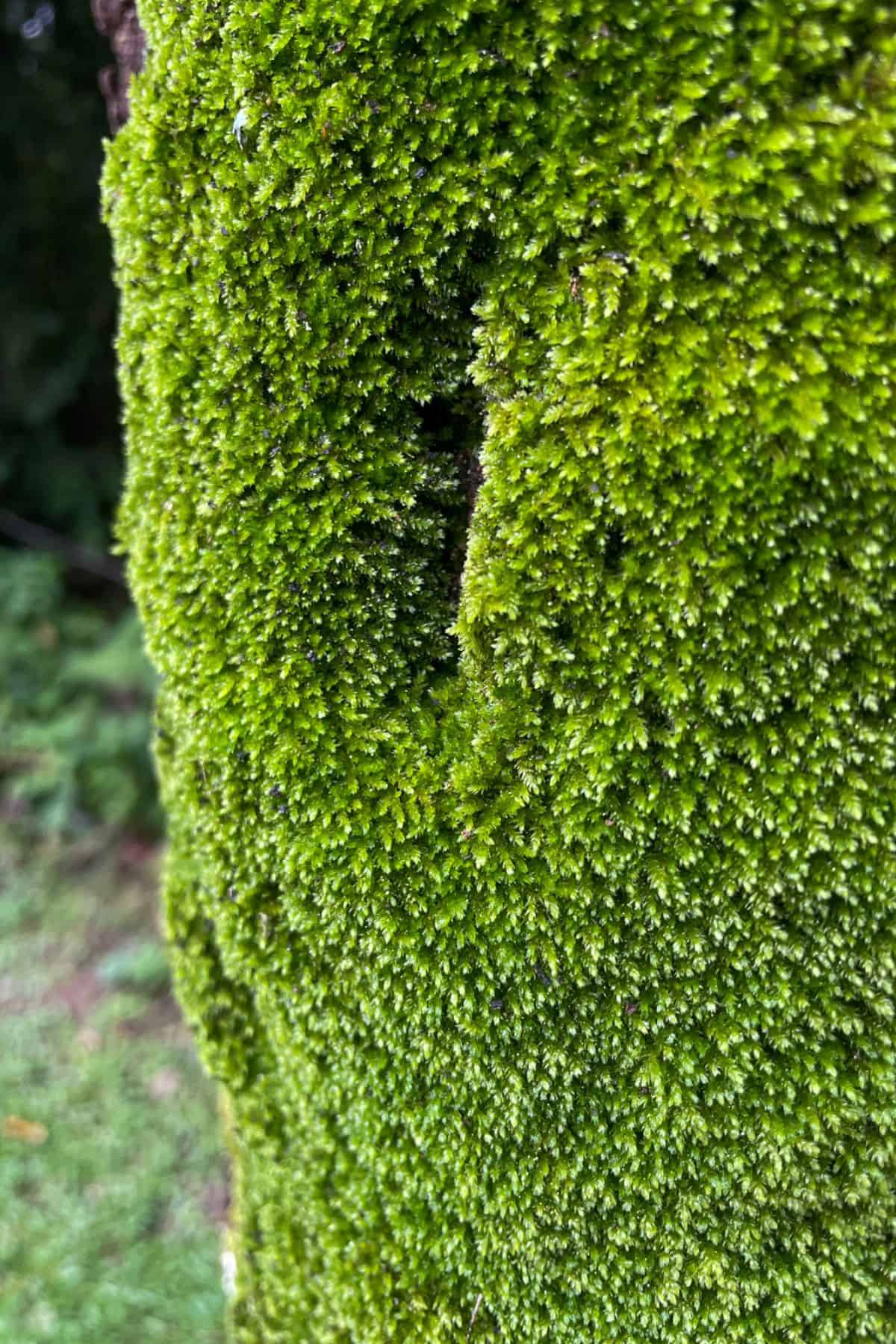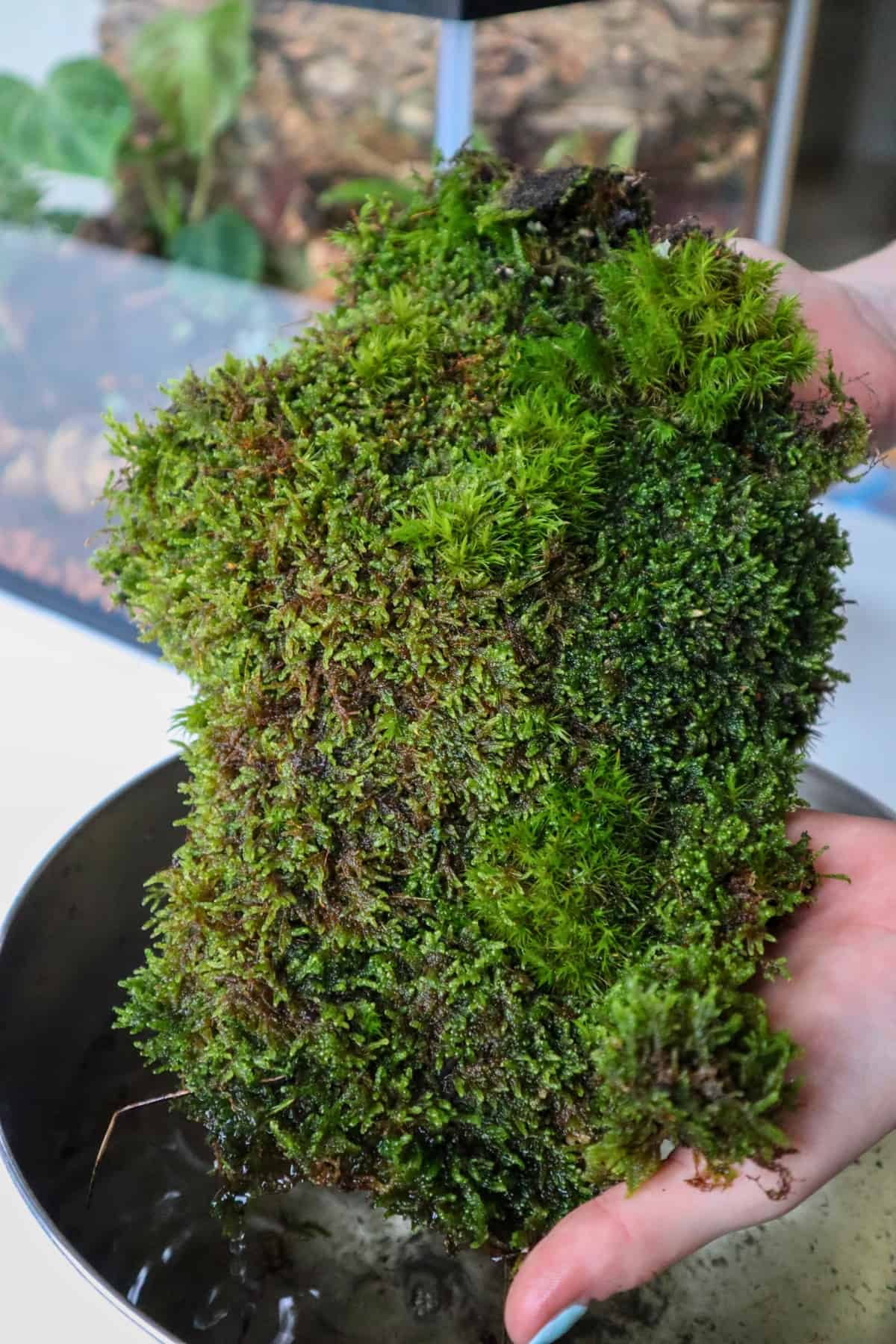Hypnum moss is a common type of sheet moss with tonnes of utility.
It grows in dense sheets, so it’s a natural fit for ground cover in terrariums and gardens alike. Plus, it’s great for covering branches and rocks, just as it would in the wild.
The creeping stems form the mat structure, which is then covered in overlapping leaves – giving the appearance of a cypress tree (hence the nickname, “Cypress-Leaved Plaitmoss”).
Naturally, Hypnum cupressiforme is actually found all over the world, so you can be confident it’ll do just fine in a variety of terrarium environments.
Find out how to get this versatile moss to flourish!

Hypnum Moss Care & Growth
| Plant Type | Moss |
| Lighting | Bright, indirect light |
| Temperature | 60-85°F (15-30°C) |
| Watering | Infrequent, even moisture |
| Humidity | High humidity (60-90%) |
| Growth | 1-5 inches |
Lighting
Hypnum cupressiforme grows best in shaded areas, with the kind of soft dappled light that reaches the forest floor in its native environment.
That’s what makes it such a popular ground cover choice in gardens too.
An unfussy species, it’ll enjoy lots of bright, indirect light but will do just fine with less, too, and can pair nicely with other low-light tolerant terrarium plants.

If you’re in the Northern Hemisphere like me, a North-facing windowsill would be an ideal placement. If in doubt, you can supplement with a grow light.
Watering
Hypnum Moss is more drought-resistant than your typical terrarium moss.
Because of this, it often arrives dried and needs to be hydrated before being placed in a terrarium.
👉 The Live Hypnum Moss on our store is dried/dormant too.
Give it a good soaking for 20 minutes or so. Just be sure to squeeze out the excess because it prefers not to be saturated with water.

Once in a terrarium build, the occasional light misting should be more than enough.
I’d also recommend using purified water (e.g., rainwater or deionized water) where possible.
Hypnum Moss is incredibly good at absorbing chemicals, to the point where it’s actually used to monitor environmental pollution in different areas. So it makes sense that it can be sensitive to tap water, and the salts can add white steaks to terrarium glass anyway

Substrate & Soil
As we’ve just covered, Hypnum Moss doesn’t like to be waterlogged, so choosing an appropriate soil is more crucial than with other mosses.
No, it doesn’t have any roots, but we don’t want it to be sat on soggy soil.
Choose a light, and well-draining tropical mix. ABG mix (or preferably a modern version of it) is a good starting point.
👉 Check out our signature tropical substrate mix for a well-balanced option.
Temperature & Humidity
Hypnum Moss grows well in warm and humid conditions, so in that sense, it’s a natural fit for closed terrariums.
However, it can be susceptible to rotting in low-airflow environments. So it’s arguably better suited to large tank-style terrariums with built-in ventilation than completely sealed terrariums.
Besides, these kinds of setups can also accommodate larger branches and rocks, where this moss really thrives.

Growth
As the ‘Sheet Moss’ term implies, this moss can grow a healthy, thick carpet.
Kind of like a swollen grassy lawn on the ground.

It’s a pleurocarp, so it grows mostly horizontally. It’ll only reach a few inches tall, making it perfect for lining the bottom of a terrarium.
In fact, this growth pattern is what makes it so easy to use in a terrarium, and I’d argue it’s the easiest type of moss I’ve worked with.
You can just lay it directly on top of the substrate in the “sheet” it’s already in.

It doesn’t have very much fibrous material on the underside (like you’d see with Pincushion Moss, for example), so unless I’m using very small clumps, I don’t tend to trim any off.
That said, it’ll trim away super easily if you want to.

Propagation
You’ll be happy to hear that Hypnum Moss will happily propagate through simple division.
Simply isolate it into patches (you can just tease/tear it apart), and they should each start a new moss colony.
In fact, for quicker mat growth, you can place a few chunks around a terrarium. That way, their outward growth meets in the middle and covers more ground.

Varieties & Similar Plants
The Hypnales family of mosses has many notable varieties and comes in various beautiful colors.
It’s technically a type of feather moss, too, but the leaves are extra chunky and rounded at the tips, so it doesn’t quite have the “light and feathery” feel as, say, an Ostrich Plume Moss. This is a heavy-duty, hardy moss!
For thick, golden-brown moss, check out Hypnum lacunosum. Alternatively, Hypnum imponens is another solid choice for ground cover too.
That said, Thuidium delicatulum is arguably the more popular type of sheet moss for tropical terrariums.

